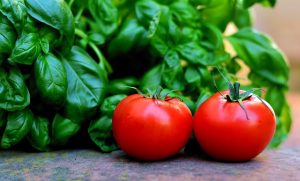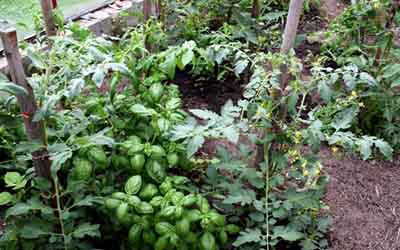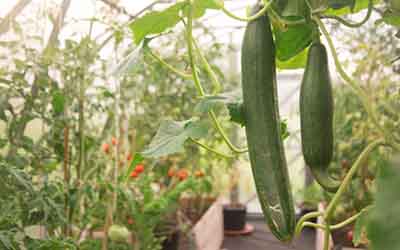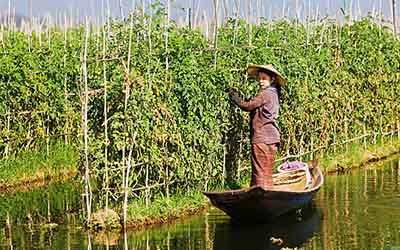What do you know about companion planting tomatoes and basil? Companion planting is an age-old agricultural practice that intertwines the growth of two or more plant species in close proximity to enhance the growth and yield of one or both plants, fend off pests, and promote other synergistic effects.
This method isn’t just a testament to the interconnectedness of nature, but also a strategic approach for gardeners aiming for a bountiful and healthy harvest.
Among the myriad of plant combinations tried and tested over the years, the coupling of tomatoes and basil stands out. Often celebrated in culinary pairings due to their complementary flavors, these two plants share a deeper bond when sown together in the soil.
Does companion planting tomatoes and basil work?
Companion planting, in its simplest definition, refers to the cultivation of two or more plant species in close proximity so that one or both may reap benefits from the relationship. This isn’t a newfangled concept but has roots deep in the annals of agricultural history, spanning various cultures and regions.
Historically, indigenous peoples around the world recognized the value of interplanting. Native Americans, for instance, practiced the “Three Sisters” method, where corn, beans, and squash were planted together, each supporting and benefiting the others in unique ways.
Such practices evolved not only from observation but also through generations of trial and error. As civilizations progressed, so did the understanding of these symbiotic relationships, leading to more refined practices suited to local conditions and needs.
Objectives of companion planting are manifold
See below;
Repelling Pests
Certain plants release compounds or fragrances that deter harmful insects. By planting these alongside more vulnerable plants, gardeners can naturally reduce pest infestations.
Improving Growth and Health
Some plants can enhance the growth of their neighbors by improving soil quality or providing essential nutrients. For instance, legumes like beans fix nitrogen in the soil, which can benefit nitrogen-hungry plants nearby.
Maximizing Space and Resources
By understanding the growth patterns and requirements of various plants, gardeners can utilize space efficiently. Deep-rooted plants can be paired with shallow-rooted ones to exploit different soil layers, ensuring that resources aren’t overly competed for.
Benefits of Planting Tomatoes and Basil Together
Tomatoes, a staple in gardens worldwide, and basil, an aromatic herb beloved by many, have been planted side by side for generations.
But what lies beneath this harmonious pairing? Let’s delve into the tangible benefits these plants bestow upon one another when they share the same patch of earth.
Basil as a Natural Deterrent
One of the standout virtues of basil is its ability to act as a natural insect repellent. Its strong aroma, delightful to us, is a powerful deterrent for many pests.
Healthier Plants
With fewer pests attacking the tomato plant, it stands to reason that the plant will be healthier, experience less stress, and produce a more bountiful harvest.
Boosted Tomato Flavor
Many gardeners and chefs swear by the improvement in tomato flavor when grown alongside basil. While empirical studies on this phenomenon are limited, the anecdotal evidence is hard to ignore.
Some speculate that the strong aromatic compounds in basil might influence the tomato’s taste profile or that the general health boost tomatoes receive from reduced pest stress contributes to better fruit quality.
Mutual Growth Benefits
Basil plants, with their bushy growth and wide leaves, can provide a microclimate for tomatoes, especially during their early growth stages.
This microclimate can protect tomato seedlings from harsh sunlight, reduce water evaporation from the soil, and maintain consistent moisture levels, which tomatoes appreciate.
Nutrient Complementarity
Tomatoes are heavy feeders, requiring a rich supply of nutrients to produce their fruit. Basil, on the other hand, is relatively less demanding. This ensures that the two aren’t overly competitive and can co-exist without depleting the soil of its essential nutrients.
Improved Moisture Retention
The dense growth of basil can act as a natural mulch, reducing the rate of water evaporation from the soil.
This not only means less frequent watering but also ensures a stable environment for the tomato roots, which are sensitive to extreme moisture fluctuations.

Practical Tips for companion planting tomatoes and basil
To make the most of the synergistic relationship between tomatoes and basil, it’s essential to consider practical aspects like spacing, planting timing, and overall care.
Here’s a guide to help you successfully integrate these two plants in your garden:
Tomatoes
Tomato plants, especially indeterminate varieties, need ample space to grow and spread. Typically, space tomato plants about 24 to 36 inches apart in a row, with rows spaced about 36 to 48 inches apart. This allows adequate air circulation, reducing the risk of fungal diseases.
Basil
Basil plants can be placed about 12 to 18 inches apart. To companion plant with tomatoes, consider planting basil in between tomato plants or as a border around them. This ensures that the aroma of basil envelops the tomato plants, acting as a natural deterrent to pests.
Efficient Use of Space
When you integrate basil into your tomato plot, you’re effectively practicing intercropping. This method can maximize garden productivity by utilizing the spaces that would otherwise remain vacant, especially when the tomato plants are still young and not fully spread out.
Symbiotic Timing
By planting basil a bit later than tomatoes, you ensure that as your tomato plants grow taller, the basil plants are growing alongside them. This keeps the basil from being overshadowed too early in the season.
Watering
Both tomatoes and basil prefer deep, infrequent watering as opposed to frequent shallow watering. Ensure that water reaches the roots, especially for tomato plants. Consider drip irrigation or soaker hoses to minimize water on the foliage, reducing the risk of diseases.
Soil
Both plants thrive in well-draining soil rich in organic matter. Regularly amend the soil with compost to provide the necessary nutrients.
Sunlight
Both tomatoes and basil love full sun. Ensure they receive at least 6-8 hours of direct sunlight daily. If your garden receives intense afternoon sun, the basil can provide some light shading for the tomato plants, but ensure both plants are receiving adequate sunlight for optimum growth.
Pruning
Regularly pinch off the tips of the basil plants to encourage bushier growth and prevent early flowering. For indeterminate tomato varieties, consider pruning the suckers (the shoots that grow in the junction between the stem and branches) to promote better air circulation and fruit production.
Protection
While basil will help deter some pests, it’s not a catch-all solution. Regularly inspect tomato leaves for signs of pests or diseases. Employ other organic pest control methods, like introducing beneficial insects, if necessary.
Potential Drawbacks or Concerns
While many gardeners sing praises for the tomato and basil partnership, no gardening technique is without its nuances.
Let’s address potential drawbacks or concerns that might arise when practicing this form of companion planting:
Water and Nutrients
Both tomatoes and basil are sun-loving plants that require a good amount of water and nutrients. When planted very close together, there’s potential for competition, particularly if the soil isn’t well-prepared or adequately watered.
Growth Patterns
Basil can grow quite bushy and might shade out young tomato plants if not appropriately managed. This can reduce the tomato plants’ access to sunlight, which is crucial for their growth.
Proximity Issues
If either plant contracts a disease, close proximity can potentially facilitate the spread. For example, basil is susceptible to downy mildew, and while this specific disease doesn’t transfer to tomatoes, the moist conditions that favor it can be problematic for tomatoes as well.
False Security
Relying solely on basil to protect tomato plants might lead to overlooking other essential pest control measures. Remember, basil might deter certain pests, but it’s not a universal solution.
Anecdotal Claims
Some gardeners believe basil can alter the taste of tomatoes. While many vouch for an improvement, a few feel it makes the tomatoes taste “too basil-y.”
Conclusion on companion planting tomatoes and basil work?
Companion planting is more than a mere gardening technique. The duo of tomatoes and basil is a prime example of how two seemingly disparate plants can come together, benefiting each other in more ways than one.
As we wrap up our exploration into the dynamic between tomatoes and basil, one thing is clear: gardening is as much about experimentation as it is about following tried-and-tested methods.
I encourage you, dear readers, to dive into the world of companion planting, and especially, to give the tomato-basil duo a shot. Your garden might surprise you with its results.
Have you ventured into the world of companion planting? Whether it’s the classic tomato and basil pairing or another dynamic duo, we want to hear from you. If you found this blog post insightful, please consider sharing it on your favorite social media platforms.
Recommendations
Does companion planting tomatoes and cucumbers work?
How To Become An Agriculturist
Artificial intelligence in agriculture projects (You don’t want to miss reading about this one)



